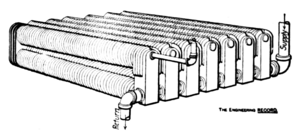that have a uniform cross-section, as the columns of most direct radiators, can be measured by determining the actual circumference of the surface by fitting a paper around it and multiplying this by the length of the column. It was once objected to this method that it does not take into account the effect of the raised ornamentation on a radiator. This is not the case, or at least any ornament that it does not take into account would not increase the total surface to an appreciable degree. Measurements of radiators by this method by different observers acting independently have been found to check within less than 1 per cent.
Action of radiators.—Before proceeding further in the discussion of radiators, it may be well to consider some of the principles which govern their operation in practical use. The fundamental principle of their operation is undoubtedly the axiomatic theory that there is a universal tendency toward the equalization of temperature; in other words, that hot bodies give up their heat to the colder ones which surround them. In general this is accomplished by three different processes, namely: conduction, convection and radiation, the word radiation being used here in the special sense of radiant heat. These may best be defined by illustrations. When one part of a rigid body is in contact with a warmer body heat passes or flows from the latter through the former to its cold por-


